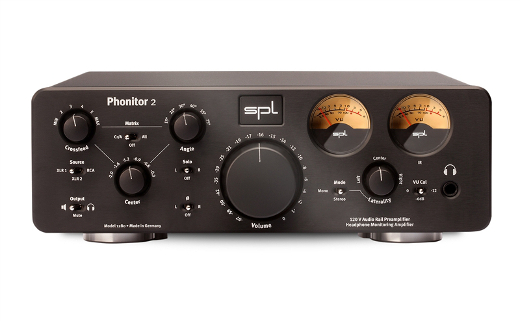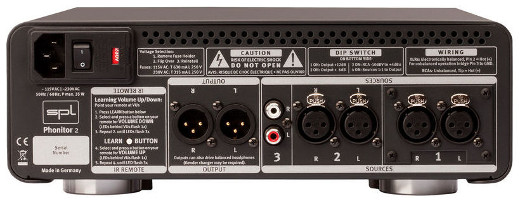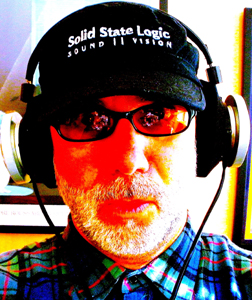Review: SPL Phonitor 2 Preamplifier & Headphone Monitoring Amplifier – by George Walker Petit
WHAT, WHY, HOW ??
You might have read my article “Mixing in Headphones” which appeared on sonicscoop.com’s website a couple of years ago. After rather verbosely delving into my reasons for incorporating this approach in my own mix process, I detailed what equipment I used to make this possible and effective.
One of the pieces of gear mentioned and still in constant use here in my NYC studio is the SPL Phonitor. I won’t duplicate the article here, but have a look if you like; a link to the article is included at the end of this review.
In short, when I first auditioned and subsequently bought the Phonitor, I became an instant fan of, and advocate for this creation, fresh from the lovely folks at SPL in Germany. The capabilities and in fact new possibilities the Phonitor introduced with its 120 volt technology, yielding incredible sound quality, added to the loudspeaker and room emulation controls and straightforward operation, made this piece of equipment an irresistible and eventually irreplaceable asset in my studio work. The Phonitor also became one of my very favorite ways of listening to music for pleasure…not work.
Yes, irreplaceable. Until now.
As it happens, I have found a machine that does everything that the SPL Phonitor does – and does it all better – better sound, more logical layout of controls, better specs. Just plain better. So, a big “I’m sorry” to my good fiends at SPL, but the Phonitor will be leaving my studio and living room this week. It will be replaced…such is the way of progress.
Phonitor, your supreme position will be usurped by…the Phonitor2 !
Why Mixing in Headphones Matters
Before the “meat” of this review, let me briefly recap my motivation for using such a device.
I believe that using high quality headphones, when used as an additional, alternate monitoring option, give the engineer a microscopic look into the mix. But a set of great cans are not enough…the correct interface with the audio is absolutely crucial. For work on noise detection, identification and control, exact panning of instruments and their effect returns, crucial balances and relative ambience, you really need to get into this sonic space.
For checking compatibility of mixes, Phonitor2 gives you phase, solo and mono switches which can be used to great benefit in a variety of combinations. Additionally, if you are a “traveling engineer” and at times have not been 100% happy with room or monitors at another studio, this device offers a brilliant sounding alternative – one that you know. You can also match monitor angle and room interaction with the Phonitor2’s intuitive controls.
Working with the original Phonitor for a few years now, I have found additional uses for it in my work…it’s truly a life-saver at times…a multi-use tool that has without doubt improved my workflow and my end product. Mixes don’t leave my room until they are checked in headphones – with the Phonitor and a set of top of the line Grado headphones. I should add that I recently tried a set of Audeze headphones out at NAMM and was hugely impressed – and hope to review those later on in the Spring.
As you can see from the images in this article, SPL have added to and improved upon the original design of Phonitor.
DESIGN AND OPERATION:
The visual aspect of the new Phonitor2 is a great improvement over the Phonitor1. The unit looks great. Mine is that sexy, black matte finish…the build quality is top shelf. It has larger footprint than the original Phonitor and is completely solid and stable on it’s four round legs.
SPL has given us more real estate with the new model. The controls on the “1” always seemed a bit cramped together for these fat fingers! And squinting to read controls has always been a bother, especially for a guy that wears glasses. So SPL spread things out a bit on the new model; more space in which to operate and a layout of switches and meters that is a far easier read for me. The meters are side-by-side, closer together than they were on the old model. The new location of the controls just works better for me.
Let’s get right into a few words on the controls themselves. The extremely clear and readable user’s manual goes deeper, but an overview of the controls is important here.
As you likely know, there are inherent issues with mixing in headphones…the super stereo effect, proximity of sound to the ears, lack of room interaction, EQ issues, ear fatigue. I tended to shy away from headphones in mixing until SPL came out with the Phonitor but, with its development, “critical listening” became truly critical. SPL designers have addressed all of these issues quite inventively and successfully.
ANGLE refers to speaker angle and controls the speaker orientation to the listener just as you would set up in your room – from 10degrees to 75degrees. CROSSFEED emulates the effects of room interaction with sound. The three controls for Crossfeed, Angle and CENTER are grouped as a triangle on the same side of the unit…this is actually a huge improvement for me over the Phonitor1, and completely logical.
SPL names this array the ‘Matrix’. Makes sense. One gets a far better feel for these controls now. Spreading the Crossfeed and Angle far L/R widens the stereo listening environment; closing the controls narrows the spread. This has now become visual as well as aural. The Center (level), which can be switched into the matrix if desired, impacts the level of signal to the center of the mix.
Headphone listening often results in a quieter center signal than is present L/R; but as you work with Crossfeed and Angle to reflect your desired monitor position and room interaction, the signal present at the center channel can increase…you can compensate for that level build up with the Center knob.
You get a three-position SOURCE switch now. Big change here on the new “2” again. The older machine had only one pair of XLR ins. But now, you have a second set of XLR ins…and an added set of RCA ins as well. Connect your converters or players…you have more options now.
The “2” also has a three-position OUTPUT switch…and here is yet another game changer. SPL decided to react to the many requests of engineers, impressed with the amazing signal quality of the unit. So impressed, in fact, that they (we) asked for a set of speaker outputs.
So now the Phonitor has become a stereo preamp…time to buy another pair of small active monitors for my trips to Brazil and Europe. What a travel rig! Switch to the left and you hit your speakers. To the right, your headphones and in the center position, the machine output is muted – you’ll see the light in the meter windows turn red in that case.
The SOLO switch is standard L, R or “off” (stereo signal monitoring). But when used in combination with the MONO switch, you get the desired left or right channels in both ears. Think of that – a possibility to identify L/R channel differences in EQ, instrument levels and placement or effect returns in mono, hearing the signal in both ears. Pretty nifty.
PHASE switching is a 180 degree phase reversal control with L/R and again, OFF. Standard and needed. But again, pair this with the MONO switch and you can hear the difference in remaining stereo information from L/R channels, depending on which channel you choose.
The STEREO, MONO and LATERALITY section is next. Aside from combinations of Solo, Mono and Phase switches to check mix compatibility, balances and hunt down distortion or other issues, you now have a control that I find particularly useful, LATERALITY. Let me quote the manual here for a sec: “…you can compensate for volume differences between channels that may be due to hearing loss…”
Having been a musician and engineer for…well, a long time, I can understand that some of us might just be missing a dB or two on the left or right side. With its super high resolution and smooth potentiometer, the Laterality control can “tilt” the entire mix to the left or right. The design behind this is smart…you are actually increasing the signal L or R when panning. For example, if you hard-pan to the Left, the L channel is increased by 3dB while the R channel is reduced by the same 3dB; the signal proportion is preserved. This is a gradual and VERY sensitive control. I love it.
As I mentioned earlier, the VU meters are closer together, allowing a reading at a glance. In addition the meters no longer display “signal present” LED’s. I don’t miss them at all. There is also no option for PPM instead of VU…again, no issue for me. The VU calibration switch is not three-position: 0db, +6dB and +12dB. The meters are super accurate and sensitive.
Finally, you have your VOLUME knob. It’s very large and very smooth – the range is from 0 to -97dB.
On the back, you’ll also see a very useful REMOTE button allowing the Phonitor2 to learn and remote for volume control (instead of having the remote learn the Phonitor2). On the bottom of the unit there is access to 4 dip switches that change output levels.
SPL engineers and designers have been at work inside the unit as well. They’ve improved their own 120volt circuit to a point where it actually surpasses THD measuring equipment capabilities. Dynamic range has been increased to 141dB, the signal to noise ratio is 107dB…all other specs have also been improved upon.
So How Does it SOUND?
All of this has had a significant effect on the sound of the Phonitor2. You’ll hear these improvements; they’re not just numbers. And this is perhaps the most important part of the new model. The increased quality of the 120volt circuit is like adding headroom to an amplifier…the more power, the better the operation and sound. Noise and distortion are virtually unmeasurable.
FINDINGS:
I spent a day A/B’ing the Phonitor1 and the Phonitor2, side by side, with a wide range of music.
I used Grado PS 500 and PS 1000 headphones for my “monitors.” Being used to the “matrix” controls from the older model, I found them to be effective and flexible – but certainly impacted by the increased specs and quality resulting from the improvement on SPL’s 120volt circuit. There is a more accurate duplication of my studio’s loudspeaker response, placement and room interaction. The “2” more detailed in matching EQ, panning and ambience. The sound stage is out of control.
Comparison is always challenging when the newer version of a unit is not “the same” as the older version. Is newer “better?” Or just different? After hearing it as “different” for a few hours, I stopped comparing and found it to be…yes…better.
I tested with familiar material and slowly the differences and improvements emerged. With a silkier overall sound which is warmer, yet not “darker” than the “1,” the new model with have an undeniable impact in the “ear fatigue” department when in headphones for extended periods. This change in frequency balance has to have been a result of the improved 120volt circuit.
The “2” sounds more present, with better detail found on all the testing and “mix applications” and on the overall sound. The depth of field is just wonderful. Listening to some old Sinatra recordings with full orchestra, I heard Frank’s vocal just that TAD in front of the band, while still a part of the band. I heard this depth better on the “2” than on the “1.”
Same reaction on hearing a fine performance of a Mendelssohn violin concerto. The soloist was ever so slightly more forward. The fiddle sounded perfectly balanced, full and warm, while open and present in a lovely hall. Listening to a favorite, the very detailed mixes on Donald Fagen’s “Morph The Cat” recording, I heard and enjoyed every sonic “splash of light,” groove or texture, thanks to the genius of Mr. Elliot Scheiner.
All as it should be…and as we should hear it to be. I listened to music from some of the finest engineers working today and in the past; and heard their Art better represented, allowing me to better enjoy the nuances of performance and the care and time put into the recordings, mixes and mastering.
I also listened to multitrack recordings and mixes of my own work, for this is where I will use the Phonitor most. I had the same positive reactions to the overall sound and the matrix controls. Every aspect of the Phonitor design seems to have been improved upon; the new additions to input/output as well as the various mix compatibility functions have all been positively impacted by the improved design.
The Value Proposition
This new unit sounds better to my ears and offers new options that increase the usefulness of Phonitor. Simple as that. Impressive, effective and surpassing even their own earlier version.
Finally, let’s consider the price as it relates to the value of this piece of gear. A simple “headphone amplifier” for about $2k (Editor’s note: The MSRP of the Phonitor 2 is $2110) is is more than a bit steep…in fact it’s far too much money unless you are one of those guys that listens to $60k speakers made a quarter-inch thick with innovative “polycarbotone gamma gas, floating in a vacuum of translucent fibers, supporting the high frequencies only discernable by one species of eastern platypus’”..etc.
I can’t play that. First off, this is NOT just a headphone amp. The 120volt technology makes it an absurd sounding headphone amplifier. But, additionally, for an engineer, it offers far more. It enables me to mix and trust the results when the room, speakers and general overall sound are lacking — and the mixes translate. I can get microscopic on problem noise issues, identify and correct them. I don’t depend on it to EQ, but it is interesting that any move in frequency correction translates to monitors as well.
The P2 gives me focus, clarity, detail and further allows me to emulate my own speaker setup in a private space. As a simple headphone amplifier, I would pit it against any and all comers, the sound is lush and real..un-hyped and multi-dimensional. It enhances my enjoyment and experience of well recorded music, of well-performed music.
Is it worth the bread? I must think it it; I bought one. The impact on my work is obvious, apparent and undeniable. Were I to lose it, I would have to replace it. Be careful…if you buy in, you’re likely to be amazed.
I’ll continue to use the Phonitor, now the ‘”2,” on every mix…here and in other studios. I have found it to be a crucial and integral part of my process.
The guys at SPL are thinking…no, sorry…listening.
— George Walker Petit thinks a lot about mixing and many other musical things. An award-winning producer and mixer, he is based in New York City. Visit George at his Website.










ashoke bhattacherjee
March 13, 2014 at 8:39 pm (11 years ago)Nice review.
So for recording guitar and other recording and listening purposes, how do i set it up with an USB audio interface?
How much will the quality of the USB interface affect the pristine quality of the Phonitor?
thanks
Modulo m
September 13, 2014 at 6:56 pm (10 years ago)If you want to listen to music from a computer you should buy a USB capable DAC with XLR outputs.
charnk
September 23, 2014 at 7:02 pm (10 years ago)Feed the monitor output of your interface into the input of the Phonitor 2. If the volume is controlled digitally, set the output to 0dB FS. In other words, all the way up. This is very important as setting a digitally controlled volume to anything less than full scale will degrade the signal. If, on the other hand, the volume is controlled by an analog attenuator, I would still turn it up all the way with the SPL Phonitor. The 120v rails allow over 30 dBu, a voltage that most interfaces can’t reach. As for your second question, if your interface is less than state of the art, you will hear it. This, in fact would be useful. You’ll hear exactly what your audience is going to be receiving from your recording. You can mix accordingly with that very useful information.
David Prats Juan
February 3, 2016 at 6:15 am (9 years ago)Thak you very much! Very interesting your review. I woul like to know if you have had the opportunity to compare Phonitor 2 with SPL 2Control. It has 2 headphone amps, also with Crossfeed feature, but with less options (and less money, too). Can this do the trick to mix on headphones or do you think it’s completely necessary the Phonitor model? Thank you very much.
David Prats Juan
February 28, 2016 at 7:07 am (9 years ago)One question more: Waves has just released their plugin NX (Virtual Mix Room over Headphones), have you tried it and compared to Phonitor 2? I’ve read some people comments saying that Waves NX is the best plugin for this purposes and, some of them, claim that in many cases they can’t find diferences between NX plugin and Phonitor.